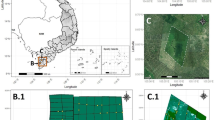Abstract
The ladybird Harmonia axyridis (Pallas) is considered one of the most serious invasive species around the globe. It has spread all over North America and Western Europe, while data from southeastern Europe, especially in the Mediterranean region, are scarce. In this study we present the first confirmed data of the spread of H. axyridis throughout Croatia. Specimens were sampled and identified during the period 2008–2010. The species was recorded at 18 localities in all three colour forms in various habitat types. Light trapping was found to be a satisfactory method for collecting H. axyridis. Since there is no evidence to suggest the deliberate introduction of H. axyridis in Croatia, it can be assumed that it has spread southwards from Central and Eastern Europe, and that it will probably continue to spread. Further investigations should focus on monitoring and detailed mapping of H. axyridis in Croatia and neighbouring countries, especially in the Mediterranean region, to determine whether stable populations are present.

Similar content being viewed by others
References
Adriaens T, San Martin y Gomez G, Maes D (2007) Invasion history, habitat preferences and phenology of the invasive ladybird Harmonia axyridis in Belgium. In: Roy HE, Wajnberg E (eds) From biological control to invasion: the Ladybird Harmonia axyridis as a model species. Springer, Berlin. doi:10.1007/978-1-4020-6939-0_6
Alyokhin A, Sewell G (2004) Changes in a lady beetle community following the establishment of three alien species. Biol Invasions 6(4):463–471. doi:10.1023/B:BINV.0000041554.14539.74
Benisch C (2007–2010) Variability of elytral color patterns in Coccinelidae. In: http://www.kerbtier.de. Accessed 12 July 2010
Borovac I (2002) The Great Atlas of Croatia. Mozaik knjiga, Zagreb (in Croatian)
Brown PMJ, Roy HE, Rothery P, Roy DB, Ware RL, Majerus MEN (2007) Harmonia axyridis in Great Britain: analysis of the spread and distribution of a non-native coccinellid. In: Roy HE, Wajnberg E (eds) From biological control to invasion: the Ladybird Harmonia axyridis as a model species. Springer, Berlin. doi:10.1007/978-1-4020-6939-0_5,_IOBC
Brown PMJ, Adriaens T, Bathon H, Cuppen J, Goldarazena A, Hagg T, Kenis M, Klausnitzer BEM, Kovar I, Loomans AJ, Majerus MEN, Nedved O, Pedersen J, Rabitsch W, Roy HE, Ternois V, Zakharov I, Roy DB (2008) Harmonia axyridis in Europe: spread and distribution of a non-native coccinellid. BioControl. doi:10.1007/s10526-007-9132-y
Chapin JB, Brou VA (1991) Harmonia axyridis (Pallas), the third species of the genus to be found in the United States (Coleoptera: Coccinellidae). Proc Entomol Soc Wash 93(3):630–635
Gotlin Čuljak T, Jelovčan S, Igrc Barčić J, Bažok R, Grubišić D, Vončina D (2006) Predator efficacy of Adalia bipunctata L. (Coleoptera: Coccinelidae) larvae and adults on aphids/VIIIth European Congress of Entomology, Abstract book, pp 150
Jelovčan S (2006) The dangerous lady beetle Harmonia axyridis P. threat to Croatia. Glasilo biljne zaštite (1332–9545) 4:242–244 (in Croatian)
Jones SC, Boggs J (2010) Multicoloured Asian lady beetle. In: Ohio State University extension fact sheet. http://ohioline.osu.edu/hse-fact/1030.html. Accessed 13 July 2010
Kenis M, Roy HE, Zindel R, Majerus MEN (2008) Current and potential management strategies against Harmonia axyridis. Biocontrol 53:235–252. doi:10.1007/s10526-007-9136-7
Koch RL (2003) The multicolored Asian lady beetle, Harmonia axyridis: a review of its biology, uses in biological control, and non-target impacts. J Insect Sci. doi:10.1672/1536-2442(2003)003[0001:TMALBH]2.0.CO;2
Kontodimas DC, Stathas GJ, Martinou AF (2008) The aphidophagous predator Harmonia axyridis (Coleoptera: Coccinellidae) in Greece, 1994–1999. Eur J Entomol 105:541–544
Kulijer D (2010) First record of invasive species Harmonia axyridis (Pallas, 1773) (Coleoptera: Coccinellidae) in Bosnia and Herzegovina. Acta Ent Serb 15(1):141–143
Labrie G, Lucas É, Coderre D (2006) Can developmental and behavioral characteristics of the multicolored asian lady beetle Harmonia axyridis explain its invasive success? Biol Invasions 8(4):743–754. doi:10.1007/s10530-005-3428-6
Lorković Z (1928) Analysis of concept and variability of species based on certain Lepidoptera. Glasnik Hrvatskog Prirodoslovnog Društva 39–40:1–64 (in Croatian)
Majerus M, Strawson V, Roy H (2006) The potential impacts of the arrival of the harlequin ladybird, Harmonia axyridis (Pallas) (Coleoptera: Coccinellidae), in Britain. Ecol Entomol 31:207–215. doi:10.1111/j.1365-2311.2006.00734.x
Masten Milek T (2007) Fauna of scale insects (Coccoidea) in Republic of Croatia. Dissertation, University of J.J. Strossmayer, Osijek
Pickering GJ, Lin JY, Reynolds A, Soleas G, Riesen R, Brindle I (2005) The influence of Harmonia axyridis on wine composition and aging. Int J Food Sci Tech 70:S128–S135
Pickering G, Lin J, Reynolds A, Soleas G, Riesen R (2006) The evaluation of remedial treatments for wine affected by Harmonia axyridis. Int J Food Sci Tech 41:77–86
Poutsma J, Loomans AJM, Aukema B, Heijerman T (2008) Predicting the potential geographical distribution of the harlequin ladybird, Harmonia axyridis, using the CLIMEX model. Biocontrol 53:103–125. doi:10.1007/s10526-007-9140-y
Roy H, Wajnberg E (2008) From biological control to invasion: the ladybird Harmonia axyridis as a model species. Biocontrol 53:1–4. doi:10.1007/s10526-007-9127-8
Roy HE, Brown P, Majerus MEN (2006) Harmonia axyridis: a successful biocontrol agent or an invasive threat? In: Eilenberg J, Hokkanen H (eds) An ecological and societal approach to biological control. Kluwer Academic Publishers, Netherlands
Roy H, Brown P, Ware R (2009) Encounters with an alien: a European perspective. BioControl News Inf 30(4):74–76
Soares AO, Borges I, Borges PAV, Labrie G, Lucas E (2008) Harmonia axyridis: what will stop the invader? Biocontrol 53:127–145. doi:10.1007/s10526-007-9141-x
Acknowledgments
We would like to thank to Ana Previšić, PhD, and Jasna Lajtner, PhD, for valuable suggestions and ideas for this manuscript. We are also grateful to Dejan Kulijer, Ivana Selanac, Ivan Budinski, Jurica Stošić and Ana Štih for sample collection.
Author information
Authors and Affiliations
Corresponding author
Rights and permissions
About this article
Cite this article
Stanković, V.M., Koren, T. & Stanković, I. The Harlequin ladybird continues to invade southeastern Europe. Biol Invasions 13, 1711–1716 (2011). https://doi.org/10.1007/s10530-010-9929-y
Received:
Accepted:
Published:
Issue Date:
DOI: https://doi.org/10.1007/s10530-010-9929-y




